 This probably seems like a strange question coming from your yoga teacher, considering that at its core, Yoga is non-competitive (unless you live in America, where the USA Yoga Federation has successfully registered yoga as an official sport, which was approved by the International Olympic Committee in 2016; and you can go and “watch” the United States Yoga Asana Championships?!) *Cue eye roll from me*. As much as it can be wonderful watching Yoga teachers (or “insta-pretty” yogis) demoing challenging poses, in my opinion, Yoga is a practice that simply cannot be competitive - it is "a journey of the self, through the self, to the self" (The Bhagavad Gita). How can we possibly compete with the person next to us during our yoga practice? We are most likely there for completely different reasons, and do not know what journey each other are on. Your favourite poses are probably totally different to theirs too (perhaps strike up a conversation and ask them next time - you might be surprised!) Competition involves rivalry. It involves trying to push past others and of course, to win. But this goes against everything “yoga” - celebrating yourself as an individual and what makes you unique; being part of an incredibly diverse, welcoming community; practicing amongst friends (even in a room full of strangers) who do not judge or compare themselves to you. “Comparison is the thief of joy” (Theodore Roosevelt), and if you are focused on comparing yourself to those around you, you are stealing from yourself some of the benefits and happiness that not only yoga can bring you, but life itself. I like to think that I am always encouraging you to accept yourself, exactly as you are, and to not compare yourself with others, and not judge yourself or others. This is because it was these messages I desperately needed to hear, that deeply planted seeds of healing in me when I first started my yoga journey. And I always make sure that my practice and teaching works to water and nurture these seeds. So why am I getting you to think about competition?! Well, I have actually realised that perhaps I do have a little competitive streak in me… Let me explain... On my own path of self-discovery, I have come to realise that perhaps I possibly use my disdain for competitiveness as a bit of an excuse to stay in my comfort zone. Competition itself has always made me feel very uncomfortable - I have never played competitive sports, and being in the Yoga industry, it is hard for me to “compete” with other Yoga teachers for business, because it goes against everything I (and my yoga practice) stand for. But as with anything, I have to ask myself - why? And I realise it is because I (as I imagine most of us do) have a huge fear of failing, or losing. If I stay here in my cosy little comfort zone, I don’t have to work very hard, and can just plod along! And that’s just human nature I suppose - we don’t like to feel uncomfortable. But if we do not push ourselves to try just that little bit harder, then we will never step out of our comfort zone. And it isn’t until we step out of our comfort zone that we progress - we begin to see growth, development and change within. Ultimately, we get to know and understand ourselves a bit better, which is of course, the purpose of our Yoga practice! There is no “perfect” in yoga. That is why it is called “practice”. There’s no getting to the “end”, but there are always ways to continue to grow and learn. Therefore, I’ve come to understand that life, like our yoga practice, is an ever-changing journey that always has something more to give us - if we can just take that little step in to the uncomfortable, unknown, and unprecedented. So just because I feel uncomfortable with competition itself, it doesn’t mean that I do not want to do well - to grow, develop and succeed. I am here to continuously strive to better myself, so that I can serve others to the absolute best of my ability. I want to be the best for you! I want to win - FOR YOU!! Namaste Yogi xxx
0 Comments
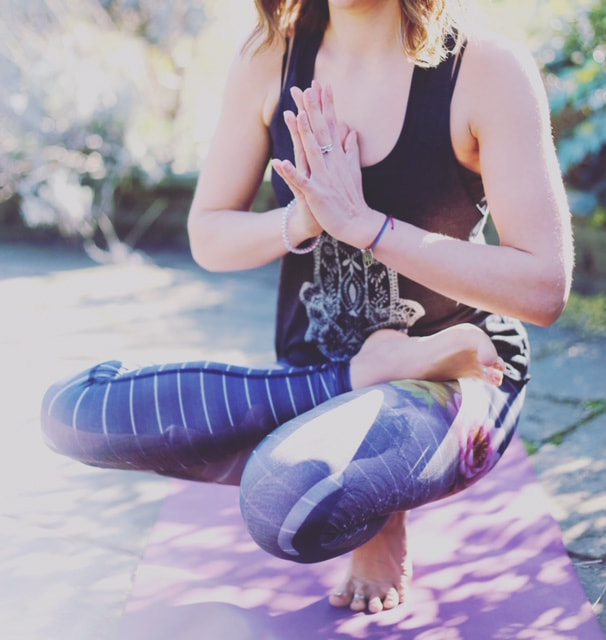 A major component of our yoga practice is to realise that all moments are fleeting. Nothing stays the same forever. As the Buddha said, impermanence is the nature of the human condition. But even though we know this truth in our minds, we tend to resist it in our hearts. Although change happens all around us, all the time, we long for the constant, predictable and consistent, because we like the reassurance that comes from things remaining the same. But as we know, there are no guarantees in life, and the only real security is that there is none! As always, what we do on our yoga mats teaches us to understand this concept of impermanence, and equips us to better cope with it in everyday life. When we practice our asanas, we often find ourselves attached to a never-ending process of "improvement". And whilst our physical practice and understanding does inevitably improve quickly at first, after some time our poses change much less, we experience smaller breakthroughs, and the “improvement” becomes subtler. Oftentimes, we can no longer practice certain poses because of age or injury, yet we feel agitated because we assume that the poses should forever be accessible to us. We are surprised when familiar asanas become difficult, and formerly difficult ones become impossible! The lesson here is that experiencing remarkable improvement on a continual basis, it turns out, is a temporary stage. Realizing this puts us in touch with the truth of impermanence, and how remaining attached to the practice of our past creates suffering within us. This is what Yoga philosophy as a whole is predicated on - the notion that identification with the temporary, changing aspect of reality leads to suffering, while recognition of the eternal, changeless Self leads to peace. Our yoga practice provides us with the realisation that we can live to the fullest when we recognize that our suffering is based not on the fact of impermanence itself, but rather on our reaction/attachment to that which is impermanent. I have to remind myself of this a lot at the moment, as I find myself in what feels like “the calm before the storm”. I am currently in a grounded and centred stage of peace and calm – which is very nice indeed! I have noticed that this tends to happen around this time of year. Once the bouncing energy of spring, with all of its freshness, renewal and vitality, has given way to the lazy, hazy days of summer (which we now seem to be in the full throes of), I feel that life calms down a little bit. For me, this time of year is about whittling down the “to-do” list, and enjoying more time outside; forgetting about the chores for a few hours and reading a book in the sunshine; going to the beach, getting in the sea; and scaling down my workload – taking a little bit of “time out” and “time off”. Maybe this sense of calm has not quite entered your life just yet, as we have not yet reached the academic “summer holidays” - but those who live by this calendar, hang in there, only one more week to go! (And for the parents/grandparents out there, maybe this is your calm before the storm – before you have to try and entertain children for a whole 6 weeks?! Brace yourselves I guess?!) However, as most of you know, I will be moving house at the end of August. Along with this, I start my pregnancy and mummy and baby Yoga teacher training in September, which runs through until December! Amidst this, I have my Sister’s 40th and Mum’s 60th Birthdays to organise and celebrate, which includes 3 parties, and a trip to Germany!! Although these are all extremely exciting things, I am very aware that the last three months of this year are going to be an absolute whirl wind of business and chaos! Thus I must not attach myself to this current state of peace –as the great Yogi, Master Patanjali reminds us in the Yoga Sutras (II.15), it is the most pleasurable things in our lives that are actually the most painful, because eventually we will have to let them go!! Namaste xxx  A couple of weeks ago I ran a “summer” cleanse yoga workshop. Then last week we connected to our masculine energy which is all about cultivating our “sun” side – can you spot a theme here?! Evidently, in the face of our typical British stop-start Summer this year, I have been trying to bring some sunshine, heat and energy in to our yoga practice instead recently! This week I have decided to address this beautiful season head on, and get us to celebrate the Summer Solstice in our practice. I think this has been timed rather nicely, what with the little heat wave that is descending upon us over the next few days. The summer solstice happens in the Northern Hemisphere around June 21st and represents the longest day of the year, the first day of summer, and also the International Day of Yoga! During the summer solstice, the sun is at its greatest distance from Earth’s celestial equator. This time of year is symbolic of transitioning from the short days of winter, in to the bright, long days of summer… yay! The term solstice is derived from the Latin “solstitium”. It is made up of the Latin sol, “the sun,” and sistere, “to make stand/stand still.” We can therefore take inspiration from the sun standing still at this time, and view this as the ideal moment to allow ourselves to come to a halt as well, and check in with where we are at this midpoint of the year. Most of the time our yoga practice encourages us to live in the present moment and to not dwell on the past or project in to the future, but during this summer period it can be good to acknowledge how far we have come this year already, and to notice the achievements we have made, or lessons learned along the way. What has the first half of the year brought you? Are you still aligned with your goals that you set back in January? Use this time to reinvigorate yourself and your goals/intentions if you need to, and decide what it is that you want the second half of this year to bring. There are also lots of other ways we can celebrate the Summer Solstice. As yogis, so many of our practices revolve around the sun, including of course, Sun Salutations (Surya Namaskar). The origin of “saluting the sun” is not about getting the perfect Chaturagna/Upward-Facing Dog alignment, but about bowing to and taking in the fiery solar energy of the sun, to wake us up, energize us, and start our day. The practice was originally taught to be done in the morning, with the torso facing the sun. Another traditional way to celebrate the solstice is to take an outdoor yoga class - a chance to reconnect with nature. Expect my classes to be outside as much as possible over the coming months! Remember a few weeks back we set the intention to be a little bit selfish? Well, this time of year is all about joy, happiness and vibrancy, so come back to your ‘love to do’ list, and see it filled with all of the things you would love to do over the summer months. Get outside and go for long, slow walks. Eat ice-cream (vegan if you like!). Bathe in the sea. Surf. Do Yoga. Spend some time with friends and family. Have a BBQ. Sip a cool beverage in a beer garden! Whatever it is, enjoy it. If you meditate, then try focusing your awareness on the Manipura chakra, located around the solar plexus. This bright yellow glowing ball of inner sunshine is the centre of our power, energy, will and achievement, and is where all of our power to manifest comes from. Happy Summer Days Everyone! Namaste xxx 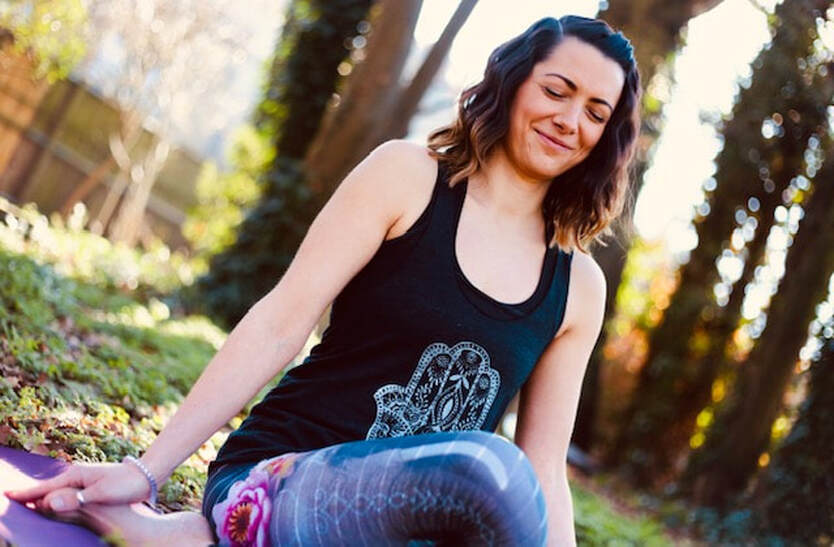 "It is not selfish to refill your own cup, so that you can pour into others. It’s not just a luxury. It is essential.” These last few weeks I have felt as if life has been so busy and chaotic that my feet have barely touched the ground, and I haven’t had much time to gather my thoughts!! Hence I’ve been slacking somewhat on the blog front. As a result, I have decided to be a little more selfish recently: to not put so much pressure on myself about writing a blog each week, and to just allow myself to write one when I feel inspired to do so; to give some time back to myself to do the things that I love, rather than feeling like I “should” be doing x, y, and z! This links in nicely with our intention of a couple of weeks ago – letting go of expectations – and also with last week’s intention – prioritising. When life gets busy, we often feel as if we “should” be prioritising our to-do list in a certain way. We believe that if we do a particular thing before we do something else, then we will get a particular outcome – but as we know from previous experiences, we ultimately have no control over the outcomes of our actions, no matter how much we plan, schedule and prioritise. Sometimes we can prioritise with the best intentions, but then something goes wrong (like a car breaking down!!), and we end up having to re-structure, re-plan and re-organise our lives. As most of us are creatures of habit, and we almost cannot help but want to have a routine in place in order to help us feel grounded and in control, a spanner-in-the-works scenario can cause feelings of stress, overwhelm and anxiety. What our yoga practice can give us, is the tools we need to go with the flow a little more, and approach re-organising our lives with a calm, level head. When our energy feels completely scattered and “out there” in the world, our yoga helps us to re-centre and re-connect our energy within. And we need to be a little bit selfish in order to do this. As always, this may seem somewhat contradictory to what Yoga is all about – thinking of others, putting other’s needs before our own, and practicing compassion. But again, there are always two sides to everything, and we need to work on ourselves in order to be the best version of ourselves, so that we can be of service to others in an effective, enthusiastic and authentic way. We need to put in the same amount that we give out: to recharge and take time for ourselves. Being selfish in this way does not mean that we care less about the important things in our lives – it simply means that sometimes those things have to wait, and our own needs must come first. We seldom do this because it feels indulgent and “selfish” to spend a bit of time on ourselves, and we tend to feel guilty about it. Or we feel that we could be doing other ‘useful’ things instead. So often our own self-care just either doesn’t make it onto our to-do list, or it gets pushed right down to the bottom, making us feel even worse for never getting around to it! We all do it - I am as guilty as anyone, especially when I’m feeling “too busy”. But it is so important to think about what we need on a daily basis to feel whole, centred and balanced. Only when we are at our best, can we truly give our best to others. Whether it is five minutes or one hour, self-care will positively impact our lives, and the lives of those around us. https://www.yogaformodernlife.com/blog/selfcareisnnotselfish has a list of 10 ideas of how to create some small acts of self-care in your life. Remember, it is important to find what works for YOU and really listening to what you need (not what you think you should do, or how you should feel). It could be eating nourishing food, getting enough sleep, having supportive friendships and a community, managing stress, exercising, or simple things that make you feel “good”. 1. Do something every day that brings you joy - It could be something as audacious as going to a spa for 2 hours, or it can be a beautiful simple activity like making and enjoying a hot cup of cocoa! Come up with a list of things you absolutely love to do, and do one each day. 2. Be mindful - Be the observer of your thoughts and actions throughout the day. Continually check in with yourself by simply watching your breath. Whenever you feel your breath get short, shallow, and in your chest, this is an indicator that you are probably tense/stressed/or just not being mindful. So practice taking 10 deep belly breaths throughout the day and feel the difference in yourself physically and mentally. 3. Set boundaries - These can be physical boundaries with certain people, places, or situations that leave you feeling uneasy, or it could also be setting boundaries from work/personal time. Setting boundaries with your energy and who you choose to be in your life is a great way to practice self-care as it protects you from giving too much of yourself to the wrong things. 4. Make compromises, but never compromise your joy – Joy comes from innate needs and wants at our core. Only you know your core beliefs and values, and it is important to stand up for what you need - in relationships, with your life, with your work, etc. So make a list of what things are non-negotiable for you to experience joy, always remember them and never compromise on them. 5. Cultivate your routine or rituals - This goes hand in hand with setting your boundaries and not compromising your joy– what routines or rituals can you develop and stick to that will help you feel loved, centred, and rooted? For example a night time routine where you make a relaxing hot drink and read in bed for 20 minutes before going to sleep – it is a very small thing, it doesn’t cost anything, but it is something that is done completely for yourself. Make a list of things you can incorporate into your routine to keep you on track. 6. Pay attention to yourself, take some time ‘being’ rather than ‘doing’ - Finding a regular yoga and/or meditation practice whereby you can slow down and really connect back in with yourself, taking some time to sense what your body and mind need, is a great way to give back to yourself. We are always busy doing this and doing that – but we are human “beings” not human “doings”. 7. Create some time for things you enjoy doing, your interests and hobbies - Too often, it can be easy for these things to fall by the wayside when our energy is spread too thinly. But doing things that you currently love, going back to a long lost interest that brings you joy, or trying out something completely new that you have always wanted to try, is so important for our mental, emotional and physical health. You CAN make time for it, you just have to prioritise a little bit of time for yourself! 8. Community and your tribe - Hang out with people who “get” you, who can respect your boundaries, your wishes and your personality. Are your relationships, community involvement, and friends, people you want in your tribe? Is there a mutual energy exchange? Do you challenge each other for growth or do you feel completely wiped out after being with them/this community? Ask yourself these questions as a way to cultivate an environment of self-love. 9. Let go - Let go of emotional baggage, of people, places, of judging yourself, of life situations that no longer serve you, and of expectations of yourself and others. From an internal standpoint, let go of certain behaviours, ideologies, pressures, comparisons – anything that limits your growth, holds you back and sucks you dry of energy! 10. Live with intention and with a greater purpose – practicing self-care is not actually “selfish” – there is a huge distinction between the two. What a little bit of self-care does is to make sure that we are being loving towards ourselves so that we are able to be present for others in our life, and on a bigger scale; the world – this is far from being selfish. It may seem a bit far-fetched to think that one individual can have that much impact on the world, but each one of us does. And collectively, if we all start to shift into practice self-care and self-love, the more love, care, and compassion we can share to others - and the beautiful cycle continues. Giving back to ourselves is to live with more intention, and to ultimately serve a greater purpose. I love what I do and I would not change it for the world. I hope that on some level I inspire and motivate people. This is why I also try to write blog posts most weeks, to better explain why I have decided to focus on a particular intention – but ultimately, if I am stressing myself out in the process, then is this not just hypocracy?! Speak soon... Namaste xxx 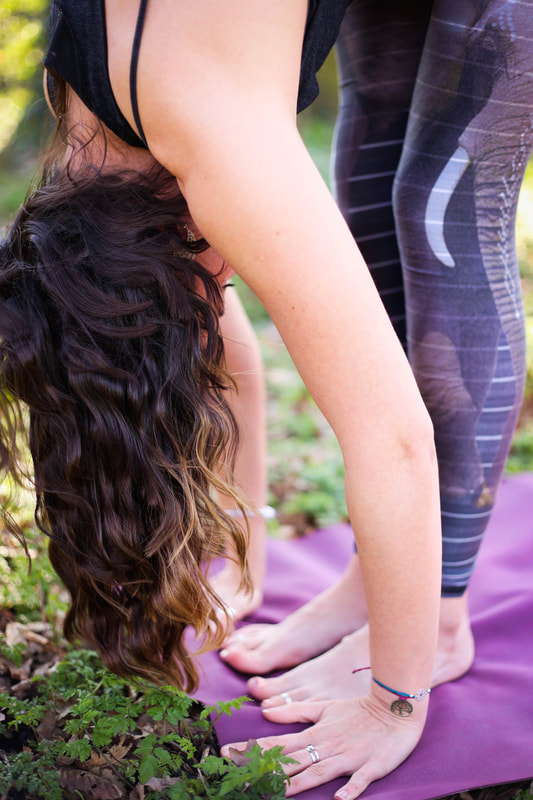 We all have expectations - of ourselves, of others, of situations/events. And that’s OK, because it is part of normal human behaviour. But sometimes, things do not quite turn out how we expected them to, and we feel sad, upset and disappointed. The problem arises when we attach ourselves to the outcomes of our expectations. Although we do not always realise it, we have absolutely no control over the outcome of our actions, and life gives us multiple opportunities to discover that we are ultimately not in charge of what happens. Even when we plan and take all of the appropriate actions, we still may not get what we want! Therefore, in order to create a happier, more peaceful existence, we need to let go of expectation and replace it with allowing. When we let go of our expectations about what should happen, we can simply enjoy life as it is. Having too many expectations and judgements can hold us back and keep us stuck in a cycle of stress, exhaustion, and ill-health. But if we allow events to happen and be as they are, if we can let go of trying to control the outcome of our actions and accept the moment for how it is right now, there would be no way we could be upset by the outcome! We may not like it, and it may not be what we planned for or expected, but accepting what is happening in the moment rather than attaching to “how it should be” can help us to relax, soften and feel more at ease. From this place, we can then more easily choose how we want to respond towards what is unfolding in front of us. Do we take a new action, or relax into what is? Or both? Often what we need is not what we want to do, but it makes us better in the end and helps us live better lives. Again as always, our yoga practice is a great way to prepare us for letting go of expectations in daily life. Think about your idea of what Yoga practitioners (or Yoga itself) “should be”, and what the practice “should” do for you? Am I less of a Yogi because I drink wine on weekends, and I am not a vegan? Am I expected to be able to do contortionist style poses in order to be a good Yoga practitioner? Is it expected of me to practice asana every single day, otherwise I cannot call myself a Yogi, let alone a Yoga instructor? We need to practice letting go of our expectations of Yoga and of ourselves as Yoga practitioners, because these expectations cause us to develop an attachment to an idea of what being a “yogi” (or aspiring to be one) should look like. But we are not less dedicated to our practice, or less affected by the transformation in our hearts and minds that our practice brings, if we do not fit a certain idea of what a “yogi” is, or what our yoga practice should do for us. During yoga class, in each pose, instead of attaching ourselves to certain beliefs about what we are expecting our bodies should be able to do, we can choose to pause, notice, and say the mantra, “this is how it is right now.” Then we can take a moment to notice what happens to our breathing and how our body feels as we let go of controlling and accept the moment. From there, we can decide what to do next: do we want to stay and enjoy it more, back off, deepen, soften, adjust our breath, or come out? When we let go of expectations and simply be in the moment, just as it is, we learn to be grateful for the opportunity to try new experiences. Just to reiterate again though, do not confuse expecting less with lowering your values or goals in life. Setting goals is important. But simply be careful about attaching self-worth and happiness to the outcomes of your expectations. It is more important to continually grow emotionally and spiritually, and to realise that whatever the outcome, even if it is not what we expected, this growth is the true, ultimate goal in life. Namaste xxx 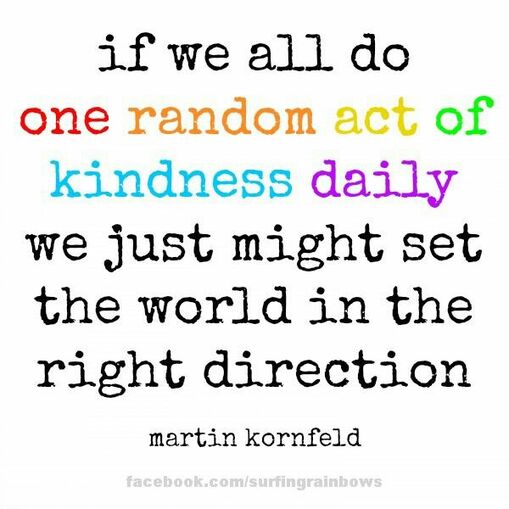 Some of the most central and important components of our yoga practice are to be compassionate, grateful, loving, kind, and to care for ourselves and others. However, every now and again, our faith in humanity gets a little shaken, and it becomes difficult to practice these positive emotions! (For me, this particularly happens when someone does not wave at you for pulling over in your car to let them past! Grrrr!) Then, something happens to restore your faith in humanity again – namely, a “random act of kindness”. Someone does or says something that just makes you feel better about life. This happened to me last week when a friend rang my doorbell with a little gift they had bought me purely because it reminded them of me! <3 When researching random acts of kindness, I stumbled across the “random acts of kindness foundation” - https://www.randomactsofkindness.org Here I found out that: 1) Kindness is teachable - “It’s kind of like weight training… people can actually build up their compassion ‘muscle’ and respond to others’ suffering with care and a desire to help” says Dr. Ritchie Davidson, University of Wisconsin. 2) Kindness is contagious - The positive effects of kindness are experienced in the brain of everyone who witnessed the act, improving their mood and making them significantly more likely to “pay it forward.” This means one good deed in a crowded area can create a domino effect and improve the day of dozens of people! 3) Kindness Increases:
4) Kindness Decreases:
So there we have it! Be kind. Think kind. Stay Kind. It will make the world a happier, healthier place! Namaste! xxx .  Whilst writing my blog last week, I realised that there is a running theme throughout each of them – that Yoga is bitter-sweet. And as we know, what we learn and discover on our mats is always a metaphor for what we learn and discover in our lives – thus life is also bitter-sweet. Think about virtually any situation, event or circumstance in your life, and you will probably find that happiness and sadness were intertwined intricately with one-another – they are somewhat inseparable. You are happy when you are eating the cake, but sad once the cake is finished (well, I am anyway – you get my drift!) Yoga is one of the biggest things that has ever made me doubt myself, knocked my confidence, and thrown everything about myself and my life in to question. At the same time, it has helped me heal, practice self-love, acceptance, gratitude and compassion. Therefore, our yoga practice is one of the most evident examples of life’s bitter-sweetness. On the one hand it teaches us oneness, completeness, wholeness, whilst on the other it asks us to dig into a deeper place within ourselves – a place we find is full of contradiction and conflict. Think about the phrase “yoga-industry” for example. This in itself is a contradiction in terms – these two parts of the statement oppose each other and render the statement false. Yoga in all its styles and traditions is a process of detaching from material concerns, but an ‘industry’ is a producer of goods and services within an economy driven by capital. Therefore, yoga, by its very nature is a non-consumerist practice, but the “yoga industry” with all of its advertising, branding and marketing speak, tells us that we need to consume the latest program or funky leggings! Toni Nagy’s article on yoga and consumerism suggests most yoga practitioners are struggling to “find a balance between living a life of non-attachment and finding the perfect outfit for doing Crow Pose”! We hence find bitter-sweetness within the one thing that that is supposed to help us find harmony and unity! As a yoga teacher, I am certainly guilty of this – I find myself talking about non-attachment whilst at the same time confessing to being a total shopaholic!! What about yoga and social media too? There certainly exists a bitter-sweetness between the ethics of yoga and a dominating visual culture here as well. Social media is a core part of modern day life and is in many ways valuable. Yoga teachers are able to use it as an extension of their teachings in the studio, and can use the technology to positively impact more people than could ever be possible in a single location. But as we know, it can also have a negative affect on the things it is used to promote. Yoga is a great example of the curse of social media, because it can make yoga appear unattainable and commercialised. On social media, the driving force for some people is a desire to be the best and look the greatest. Straight off, this goes against the yogic principle of detaching oneself from the “ego”. Ultimately, what this visual culture of images has led to is the development of "master yogis" who dedicate their days to pulling off cool yoga stunts in dramatic places, or seemingly impossible contortionist poses. And while these pictures can be wonderful to behold, there is also a counter to this display of brilliance. These images often lead to comments such as "Wow, I wish I could do that, but I'm not flexible enough for yoga", which again goes against every principle of yoga, and instead of encouraging us to try it, we are instead seeing it as something that is unattainable. Whilst anyone could learn to improve themselves with yoga through beginners yoga classes, it is instead thought to be too hard and so there is no point even trying. When we look at yoga on social media, we quickly get the idea that yoga is for bendy, mostly white, slender, occasionally scantily clad, women in their twenties or thirties. Of course, they have every right to post those photos. But where are the pictures of everybody else? What about the image of older people and yoga? Where are the yogis working with physical challenges? Again and again we are served up the perfect yogini who looks like a model and is seemingly brimming with natural health. But yoga is meant to be an accepting practice for people of all shapes, sizes, and backgrounds, and ironically, those of us most in need of yoga, especially the therapeutic aspect of it, are nowhere near a yoga class! Also, the image of yoga that is often presented is one of vegans and hippies! And for many potential yoga practitioners, this can be a put-off because they do not want to be pressured to change their diet or be judged for their wider lifestyle. …Again, bitter-sweetness rears its head. So how can we feel balanced, whole and complete by practicing something that seems so contradictory? Well yes, in a world that likes easy answers, yoga confronts us with nuance, complexity and contradictions, but the practice also grows our ability to be with all of this at once. I always stress in my teachings that our yoga practice is not just doing exercises in the sense of gym or studio class, or posting our “successes” on social media, but the real work is in taking an honest look at ourselves, perceiving all that we are made up of in order to move closer to equanimity and balance. Yoga, in all its bitter-sweetness, gives us information and experience so that we can better navigate through this bitter-sweet world. We learn that there will always be a bad to every good (a yin and yang), and that something can seem good or bad based on perspective or the context. Bitter exists to make us understand and enjoy sweet. We experience bad things in order to grow and understand what a good thing is – there is always beauty to be found in darkness, and peace to be found in turmoil. Because life is made up of opposites, it therefore has every possible potential! And most importantly, Yoga teaches us that everything ultimately exists inside of us anyway, so the choice of what we feed within is all our own doing. This is why happiness to one is misery to the other. And it is within this fact that the magic of yoga really exists - we are the masters of our own practice and therefore our lives. We can choose to feed negativity, dislike and bitterness, or we can feed love, move from a place of compassion, and create more sweetness in our lives. The best I can do as a yoga teacher, feeling conflicted myself, and trying to teach a practice of non-attachment and ego-eradication whilst wearing the latest recycled plastic leggings, and posting photos on Instagram, is to be humble, honest and authentic. And as the saying goes – when life gives you lemons, make gin! 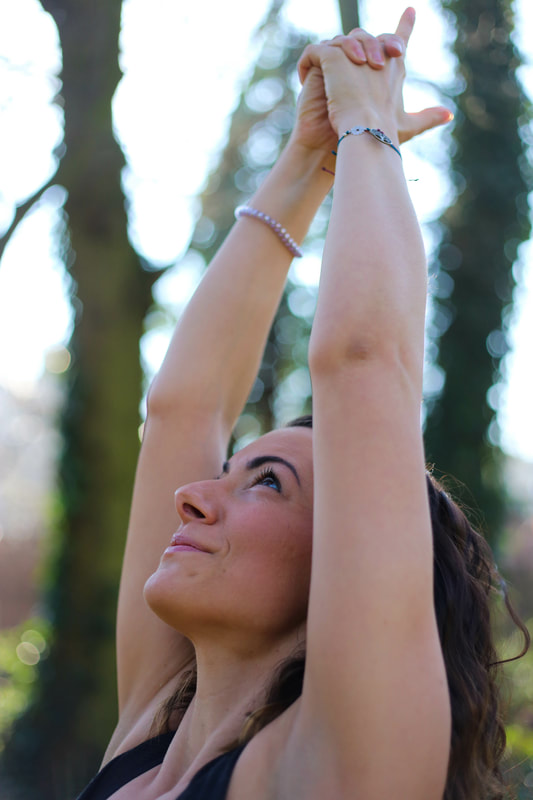 I had a sense that the Easter bank holiday weekend could bring upon us the self-consciousness that comes from being thought lazy or making less than healthy choices! So I wanted to address the concept of “feeling guilty” in last week’s classes. Experiencing a feeling of guilt from time to time is an important and natural function of human conscience. It serves a role in the development of an ethical sense, discouraging us from harming ourselves and those around us. A modicum of guilt when recognising our overindulgence, or when blurting a damaging, snarky remark, helps us modify such behaviours in the future. This type of natural guilt is also reparable - you can make amends, ask for forgiveness, and pay your debt. Once the transgression has been addressed, the guilt should dissolve. However, while natural-guilt may prompt us at times to return to a healthier path, or to keep our criticism of others in check, no amount of remorse will make us perfect, and may well actually create a major obstacle to personal growth if left unaddressed. Guilt is heavy baggage and we do not want to carry it around. Allowing guilt and shame to fester and turn toxic within ourselves, leads to an underlying sense of not being a good person, which in turn causes negative self-talk and bad feelings that can, in fact, be out of proportion to the original guilt-causing-offence itself. Thus it is important to learn how to recognise and deal with our feelings of guilt when they arise, so that they no longer have the power to program us from the inside. And this is where our yoga practice may come in handy. There are, as we know, a lot of conflicting and contradictory messages in the Yoga world. More often than not, we associate words like enlightened, skilful, balanced, aligned, mindful, fun, and even sexy with yoga practice. Thanks to social media, and our cameras living in our pockets, there is a trend toward making yoga practice look idyllic. Shots on beaches, with well-behaved babies, pets, romantic partnering, glorious arms and legs and flexible spines, permeate our consciousness on a daily basis. However, when it comes to our own practice, the reality is that we often feel confused, lopsided, awkward, scattered, struggling, and unattractive in our yogic efforts! Our humble, sweaty attempts at pyjama-clad sun salutes in our cluttered living rooms are a far stretch from the marvelousness that is the picture-perfect yogic lifestyle! Then, no matter how many times Yoga attempts to remind us that we are there for our own practice, and that non-possessiveness, non-grasping, and non-greediness are yogic virtues, these tendencies arise within us and we compare ourselves to others anyway! And so comes the tidal-wave of “feeling guilty” along with all of its primordial self-hatisms - “I am not good enough, or thin enough, or poised enough, or smart enough”. So Yoga can be a bit bitter-sweet when it comes to guilt. Ultimately though, what our yoga practice does do is to ask us to reflect on our actions and behaviours towards ourselves and others, and teaches us the value of “ahimsa” – non-violence. Ahimsa is the first Yama (the necessary self-discipline that allows us to head toward the fulfilment of our dharma, or life purpose – see last week’s blog!) in the Yoga sutras of Patenjali. Therefore, allowing feelings of guilt to take over and alter our thoughts and behaviours in a harmful way is actually detrimental to our journey on the yogic path. Dr. Marshall Rosenberg, world-renowned psychologist, author, and peace maker, teaches in his book “Nonviolent Communication” that guilt and shame are the most internally violent emotions we possess. Often we jump through hoops not to potentially harm another person, but we will so readily “beat ourselves up” with negative self-talk! Guilt and shame are the inevitable toxins of any belief that equates our worth based on actions rather than our “Being”. Yoga is a practice that helps us understand ourselves as a Being - a divine member of the oneness of all things and valuable simply because we are. Therefore, yoga reminds us that we are human beings, not human “doings.” And when our Yoga practice is used as a tool to explore our feeling and to help us remember what really matters and who we really are, our guilt and shame can be turned from neurotic over-processing into a means of learning and expansion. By investigating where our guilt is coming from and what kind of guilt we are feeling, it is easier to see how to get rid of it (making amends for something, working through it, or simply letting it go). Eradicating our guilt means that we are practicing internal non-violence; we are able to realise that when embarrassment and guilt no longer serve us, they can be left behind—just as a snake sheds the skin that was limiting its growth. As human beings we all make mistakes. And sometimes, despite our best intentions, we do things that we know are not good for us or other people - and we feel guilty for it. But Yoga encourages us to develop an exquisitely scrupulous conscience, by holding ourselves to the ethical standards of the yogic path, making it harder to let ourselves get away with insensitive or harmful behaviour. Our yoga practice therefore teaches us to have a healthy relationship with our personal guilt, so that we do not agonise over guilty feelings. Instead, we are able to use them as signals to change our behaviour and make self-love part of our yoga practice, building ourselves up instead of beating ourselves down. When we start to do this regularly, the world seems much more bright and beautiful. It becomes much easier to be kinder to the world around us, and magically it feels as if the entire world became kinder, less judgemental, and more compassionate too - because it did. And as with everything, it started from within. Namaste xxx 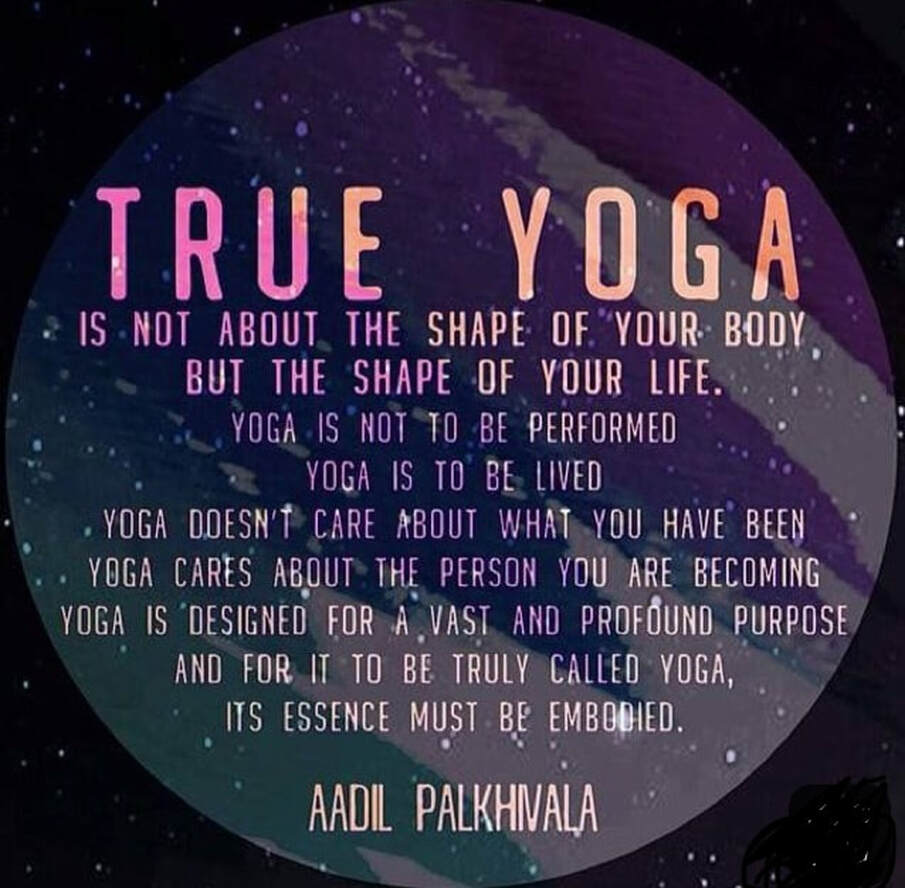 “The biggest threat to our well-being is the absence of moral clarity and purpose.” — Rich Sherman Have you ever noticed how much happier and grounded you feel when you have a sense of purpose; when something you have said or done has had meaning behind it, and possibly had a positive effect on yourself or something/someone else? Life seems so much brighter when it is more than simply eat, sleep, wake up, get things done, rinse and repeat. This is because purpose guides our life decisions, influences our behaviour, shapes our goals, offers a sense of direction, and creates meaning to our lives. For some of us, purpose is connected to vocation--meaningful, satisfying work. This is definitely the case for me. I teach yoga and offer massage therapy because I love to utilise my passion for something, turn it in to a skill, and then transfer it on to others in the hopes that it will make them feel good about themselves. It is why I set intentions and write blogs most weeks. The hard work and fear over sharing some of my most personal insights, feel worth it when I realise that I have managed to resonate with even just one other person that day/week/month. For others, purpose lies in responsibilities to family or friends, or through spirituality/religious beliefs. Some people may find their purpose clearly expressed in all of these aspects of life. Your purpose will be unique from everyone else’s; what you identify as your path may be different from others. Moreover, your purpose will actually shift and change throughout life in response to the evolving priorities and fluctuations of your own experiences. Ultimately for all of us though, our life’s purpose is the message we wish to drive forward in the world during our time on Earth. Nobody wants to live in chaos, and without focusing on our life’s purpose, we are bound to feel lost, depressed, anxious, and feel a sense of meaninglessness. A lot of psychological literature clearly states that there is a link between feeling like we have a purpose and our psychological well-being. Having a meaningful pursuit in your life acts as a buffer against stress, negative emotion, and makes you more likely to engage in health-promoting behaviours. It even helps you sleep better at night! Therefore, to have a goal, a purpose, is to organize the world around you, and to move through time in a meaningful way, carving your way through the chaos of life! Taking the time to discover your purpose means that you are passionate about living your best, most conscious life. This does not mean that all of your problems disappear; it simply means that with a clear purpose, you can then set the right goals and plans, and take the right daily steps to create your most meaningful life. Think about my blog post on making decisions a couple of weeks ago. Understanding what our purpose is in life, will help us to make better decisions about our actions and behaviours, which will ultimately lead to more desirable outcomes and manifest a more meaningful, positive life for ourselves. As with decision-making though, when trying to figure out our purpose, we need to differentiate between the important and unimportant, so that we can cut through the cr*p and get right to the things that matter! When we begin to direct our focus to the really important things, life becomes filled with direction and meaning, instead of wasting time on inconsequential stuff. For example; as opposed to wasting time in a job you do not love, you can now work toward a career that better fits your purpose; as opposed to being around toxic people who are incompatible with you, you can now find people who share the same values to build your highest life; as opposed to living a random existence, you can now create your life of the highest meaning. Thus it is important to identify what you truly care about, and then direct your energy to making this a reality. When we find what our purpose is, we will naturally want to devote our life to pursue it because we care about it, it gives us the most fulfilment, and we will naturally get better at it because the time we spend on it will give us the experience and skills to succeed. So where does Yoga fit in to all of this? We already know that traditionally yoga was practiced and developed to open the body and clear the mind, so that one can sit and meditate without dwelling on a stiff back or congestion in the process of thought. More often than not we practice yoga simply for its physical benefits of having toned muscles, flexibility, and mental clarity. But what about the philosophical side of this wonderful ancient practice? Practicing Yoga and meditation enables us to be free and clear to focus our attention on the deeper imperative questions of life like 'who am I?', 'what is my purpose?', 'why do I exist?'; and to seek out the answers. Our sense of purpose often arises from this curiosity about our own life. What obstacles have we encountered? What strengths helped us to overcome them? How did other people help? How did our strengths help make life better for others? Our yoga and meditation practice allows us to cultivate a deeper sense of who we are, and fill any gap in our lives, giving us a true sense of completeness. On another note, ancient Yoga is derived from Indian Philosophy and religion, of which the concept of “Dharma” is of central importance. Dharma has multiple meanings in Hinduism, Buddhism, and Jainism, so it is therefore difficult to provide a single concise definition of the word - it has a long and varied history, and straddles a complex set of meanings and interpretations. There is no equivalent single-word synonym for dharma in western languages, and numerous, conflicting attempts have been made to translate ancient Sanskrit literature with the word dharma into German, English and French. There are over twenty different translations for dharma, including meanings such as statute, law, practice, custom, duty, right, justice, virtue, morality, ethics, religion, religious merit, good works, nature, character, quality and property. Yet, each of these definitions is incomplete, while the combination of these translations does not convey the total sense of the word. In common parlance, dharma means "right way of living" and "path of rightness". In the context of Hinduism (which heavily influences the practice and teachings of Yoga), dharma designates human behaviours, rituals, rules that govern society, and ethics considered necessary for the order of things in the universe - principles that prevent chaos in the world. Hindu dharma includes the religious duties, moral rights and duties of each individual, as well as behaviours that enable social order, right conduct, and those that are virtuous. Living out one’s dharma can therefore be synonymous with living out one’s purpose in life; contributing to the peaceful and orderly running of society. Finding our purpose is to pursue and execute our individual true nature and calling, thus playing one's role in the cosmic concert. For example; it is the dharma of the bee to make honey; of cow to give milk; of sun to radiate sunshine; of river to flow. In terms of humanity, dharma is the need for, the effect and essence of service and interconnectedness of all life. Each individual carrying out their dharma, their purpose, acts as the regulatory moral principle of the Universe. So how can Yoga help us to find our purpose? Remember the Yoga sutras of Petenjali? Our dharma (purpose) is played out in the first and second limbs of the eight-limbed path of yoga – the yamas and niyamas (external and internal moral codes) that we live by. In the Yoga Sutras, Patanjali describes yoga as “the progressive quieting of the fluctuations of the mind.” Thus through dedicated practice and the cultivation of detachment, we will stop identifying with the thoughts, feelings, and sensations that can cause us so much emotional pain—and we will open to an experience of our true self. As Patanjali and so many other wisdom teachers have taught, who we really are goes beyond the labels and titles we often use to define ourselves. Therefore, practicing yoga and meditation can help us to discover our true purpose in life, instead of simply attaching labels and stories to ourselves and believing that to be our purpose. However, finding our purpose is not just an intellectual pursuit, it is something we need to feel. Yoga also helps us to cultivate within ourselves certain emotions and behaviours that promote health and well-being, which in turn foster a sense of purpose. Gratitude and altruism for example, can drive us to make a positive impact on the world, and these two qualities work together to generate meaning and purpose in our lives. In the face of one’s own or others’ suffering, if we are able to count our blessings and still give thanks, we are much more likely to contribute to the world beyond ourselves. And there is little question that helping others is associated with a more meaningful, purposeful life. People who engage in more altruistic behaviours, like volunteering or donating money, tend to have a greater sense of purpose in their lives. Yoga embodies this type of behaviour. You can also find purpose in what people thank you for. Appreciation from others will fuel your passion and therefore your work. People thanking me for my classes and massages and telling me how much of an impact I have had on them, keeps me going. It encourages me to want to learn and develop more, so that I am better able to help others and continue to fulfil my life’s purpose. We can also often find our sense of purpose in the people around us, and we all know that Yoga brings people together. This links in with the concept of dharma. If each individual is able to find their true calling and foster their own sense of purpose, then humanity is more likely to accomplish big things by working together peacefully. Purpose is adaptive in an evolutionary sense, and therefore helps both individuals and the species to survive. Purpose does not simply arise from your own special gifts and what sets you apart from other people, it also grows from our connection to others. So we need to recognize our own gifts, but use them to contribute to the world; whether those gifts are playing beautiful music for others to enjoy, helping friends solve problems, or simply bringing more joy into the lives of those around you. If you are having trouble remembering your purpose, take a look at the people around you. What do you have in common with them? What are they trying to be? What impact do you see them having on the world? Is that impact a positive one? Can you join with them in making that impact? What do they need? Can you give it them? If the answers to those questions do not inspire you, then you might need to find a new community—and with that, a new purpose may come. When your authentic purpose becomes clear, you will be able to share it with the whole world, and to live this way is deeply meaningful. Namaste xxx 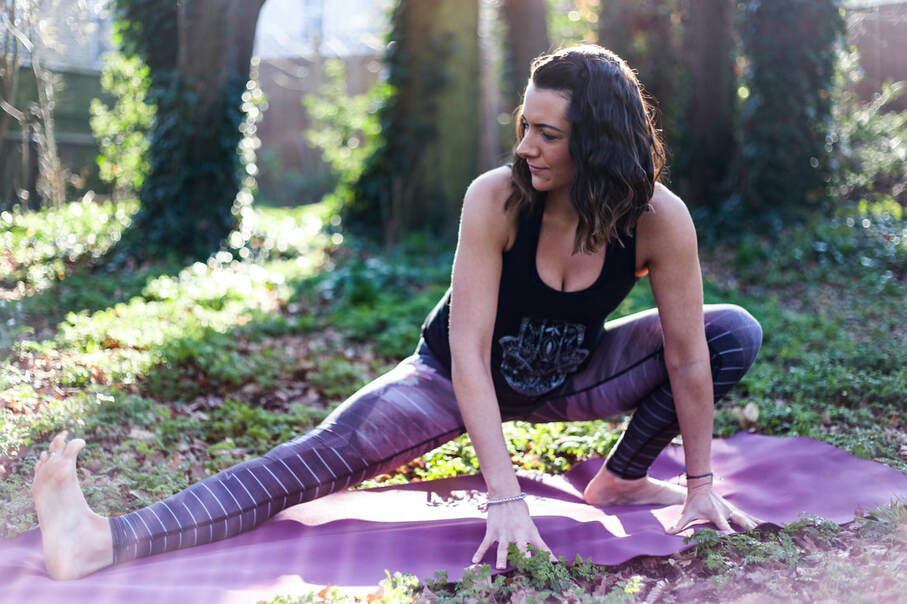 Photo by Sue Devenish Meares Photo by Sue Devenish Meares Ironically, I do not think there is enough time in the world to fully and completely cover the complex and complicated subject of time. Even physicists agree that time is one of the most difficult properties of our universe to understand. As someone who is late for most things, I feel that time is a conspiracy anyway!! But after many recent conversations about how time seems to be whizzing past us (we are quarter of the way through 2019 already!), and one yogini feeling absolutely terrible about turning up 4 minutes late for my workshop at the weekend explaining that she, like myself, has no concept of time-keeping and cannot work out how to change her perception of time so that she can be on time for things, made me think about ways in which we can somehow claw back a bit of time! In general, the Islamic and Judeo-Christian world-view regards time as linear and directional, beginning with the act of creation by God. In the modern Western world, it is this view of time that we still currently have. There is a past, a present and a future; and life is a series of events one happening after the other. However, the Ancient Greeks, Hinduism, Buddhism, Jainism, and other religions have a concept of a wheel of time: they regard time as cyclical and quantic, consisting of repeating ages that happen to every being of the Universe between birth and extinction. Yoga, being heavily influenced by Buddhism and Hinduism, also views time as cyclical. If we think about it, all of our most common time measurement systems we use in daily life are cyclical – the moon, the seasons, the days in a week/month/year, etc. A post on www.theperspective.com explains how, “until recently, the lives of agricultural, nomadic, and even urban peoples were governed by the endlessly repeating seasonal round. Calendars, which portray time as a linear concept, are a recent phenomenon when compared to the long-term existence of our species. The earliest calendar may have developed as early as 10,000 years ago; well-documented calendar systems do not become common in the archaeological record until within the last 5,000 years. Our species is 200,000 years old; so for at least 95% of humankind’s existence as a species, time was cyclical and circadian”. The post goes on to ask, “What is the difference between the Hebrew, Chinese, Gregorian, and Mayan calendars? Ultimately, from the perspective of time itself, not much. These calendars have different origins, starting points, counting systems, and holidays that are relevant only to people, not animals, plants, or the planet. In the end, each of these calendars is nothing more than a cultural construct based on local political, religious, scientific, and economic systems created by humans”. This leads me on to Einstein’s theory of relativity. Now, I am not even going to even attempt to explain this in any detail, because it is far beyond the scope of my own intellect, and the point I want to make in my Yoga classes this week! But simplified, Einstein says that time is a relative concept – it speeds up or slows down depending on how fast you move relative to something else. Also, apparently, the higher you live above sea level, the faster you should age, because gravity can also bend time! Before this gets way too mind-blowing and complicated, the point is that Einstein’s theory proves that time and space are not as constant as everyday life would suggest. Think about how time seems to fly by when we are having a great conversation with a friend, or when we are doing something we love. And how it also seems to slow down when we are doing something we find boring? How can time be an objective constant in this instance? Our idea of time comes from the Newtonian paradigm, which says that there is only a finite amount of time - it assumes that there is a scarcity of time. This is what gives us the feeling of urgency – the feeling that we never have “the right amount of time”. There are never enough hours in the day. Thus we are always busy and rushing, trying to stay ahead of the clock and fit in as much as possible in a week, half a day, or an hour. There is a book by an author called Gay Hendricks which personally I have not read yet, but in it, he explains that, “At the heart of the Newtonian time crunch is a dualistic split: we are deluded into thinking that time is ‘out there’; an actual physical entity that can put pressure on us ‘in here’.” But, “When we switch to Einstein Time, we take charge of the amount of time we have. We realize that we’re where time comes from. We embrace this liberating insight: since I’m the producer of time, I can make as much of it as I need,” says Gay Hendricks. As soon as you stop thinking that time is ‘out there’, you can take ownership of time. If you acknowledge that you are where time comes from, it will stop owning you. You won’t be the slave of time anymore. And now, the only thing to do is to implement this insight… The Huffpost has a great article that may come in handy here. A few tips about how to master your own time: 1. Take a deep breath. Most of us will say, “But I do not have time to take a deep breath!”, and that this “deep breath” idea is just cliché. But really, we all have enough time to take a full, complete, deep inhale and exhale. Try it now. When you do, you might actually feel time expand a tiny bit. And if you take a few, deep breaths, you might feel it expand even more. Doing this will oxygenate the body and mind and give yourself a chance to approach things more calmly, which will in fact feel like time expanding. 2. Make a list and get out of your head. Remember my post on feeling overwhelmed?! Making a list might seem a laborious and time-consuming task in itself, but doing so will free your mind from overwhelm and put all of the things you need to do in front of you. This way you can see them, approach them, and deal with them one by one; giving you more time in the long run to slowly get everything done. Put your list in order of importance. Prioritise the big things, and before you move on to everything else, tackle that task first. 3. Combine efforts. Try to schedule things so that all of your activities fall back to back on the same day — making for a busy day, but also leaving other days of the week open for you to feel more spacious. 4. Schedule less. It may seem obvious, but if overwhelm is becoming a regular state of mind, and you are feeling yourself never having enough time, perhaps you ought to think about doing less. If it is making you stressed or anxious, then maybe it really is too much. Whatever you give up for now will be there when you are ready to approach it again, but you are not serving anyone by completely overextending yourself. 5. Delegate. Ask yourself if you really need to do everything yourself? Maybe try looking to friends, colleagues or family members who might be able to pick up some of the slack for you. This could simply be out of the kindness of their own hearts (and more often than not, it will be), or in exchange for other tasks that you are doing anyway. Share, trade, barter, bargain: whatever you can do to make things feel more efficient and fun. 6. Get more sleep. It seems funny to think of sleeping more as giving you more time, but everyone knows that when you are well-rested you are a much more efficient machine. Try going to bed 30 minutes earlier, and leave something undone that night. You will feel stronger, more capable, more efficient, and happier too – then you can get more done more joyfully the following day. In our modern age, there is always one more thing that needs to be done. One more thing that creeps in to our time schedule and sucks precious time away from us! To battle against this and gain some time back for yourself, decide from the very beginning what is most important – your mental and physical health, or doing the hovering?! Remember that time is relative and cyclical. The ageing process, from birth to eventually giving ourselves back to the earth, is simply the “circle of life”. So why not have a blast whilst we are here for now, and spend our time doing more of the things we enjoy! Namaste xxx |
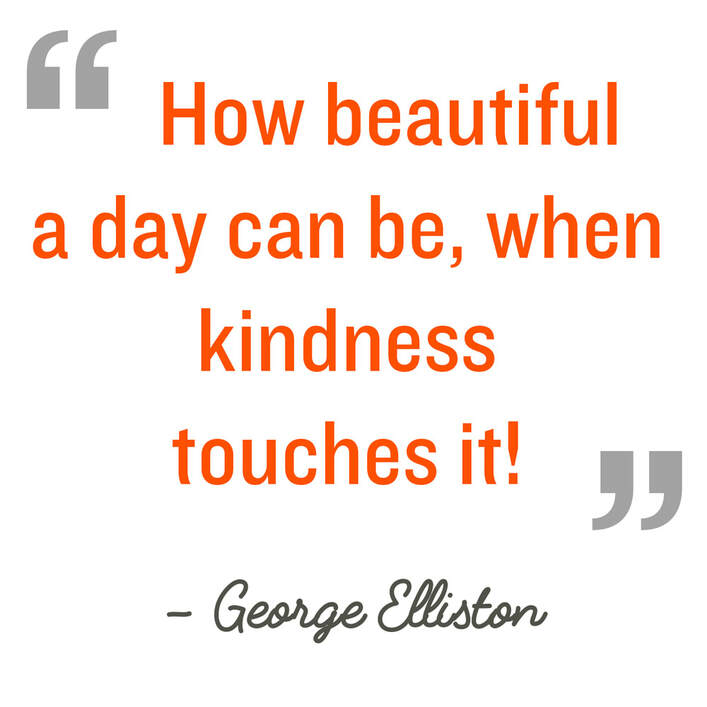
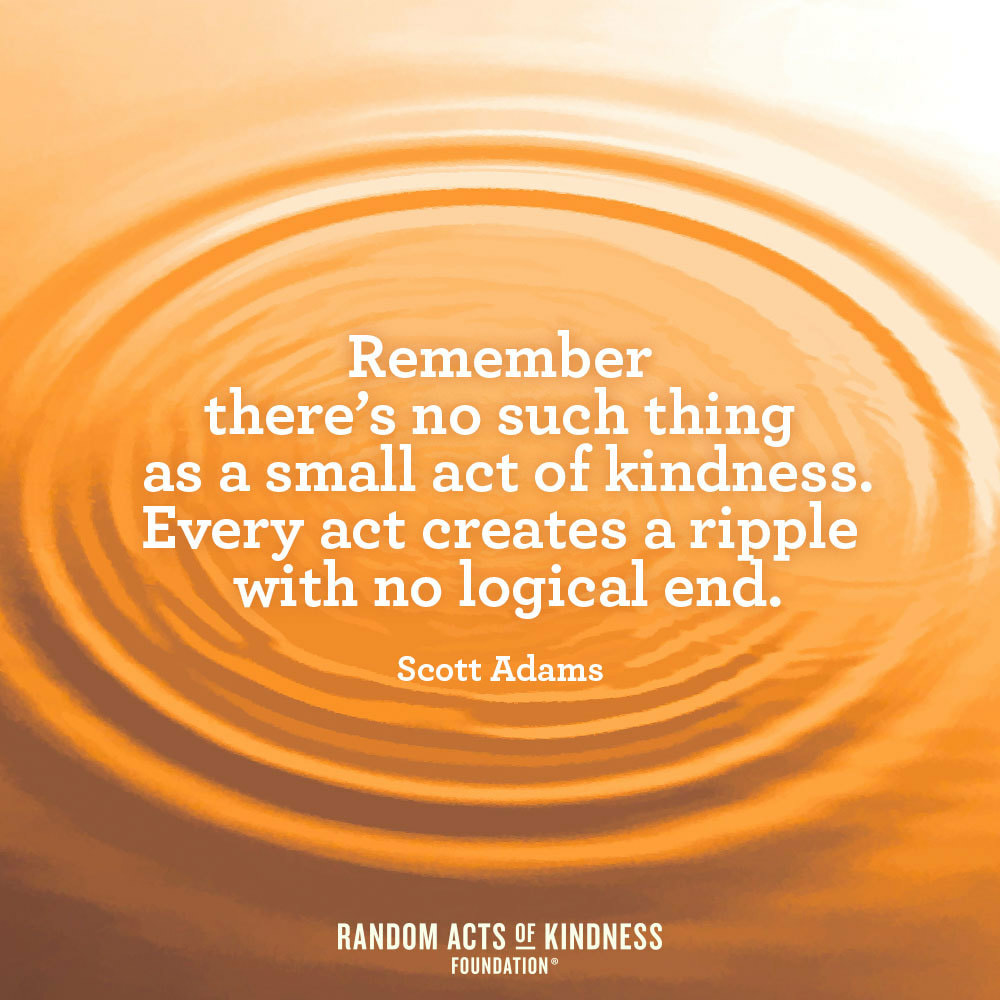
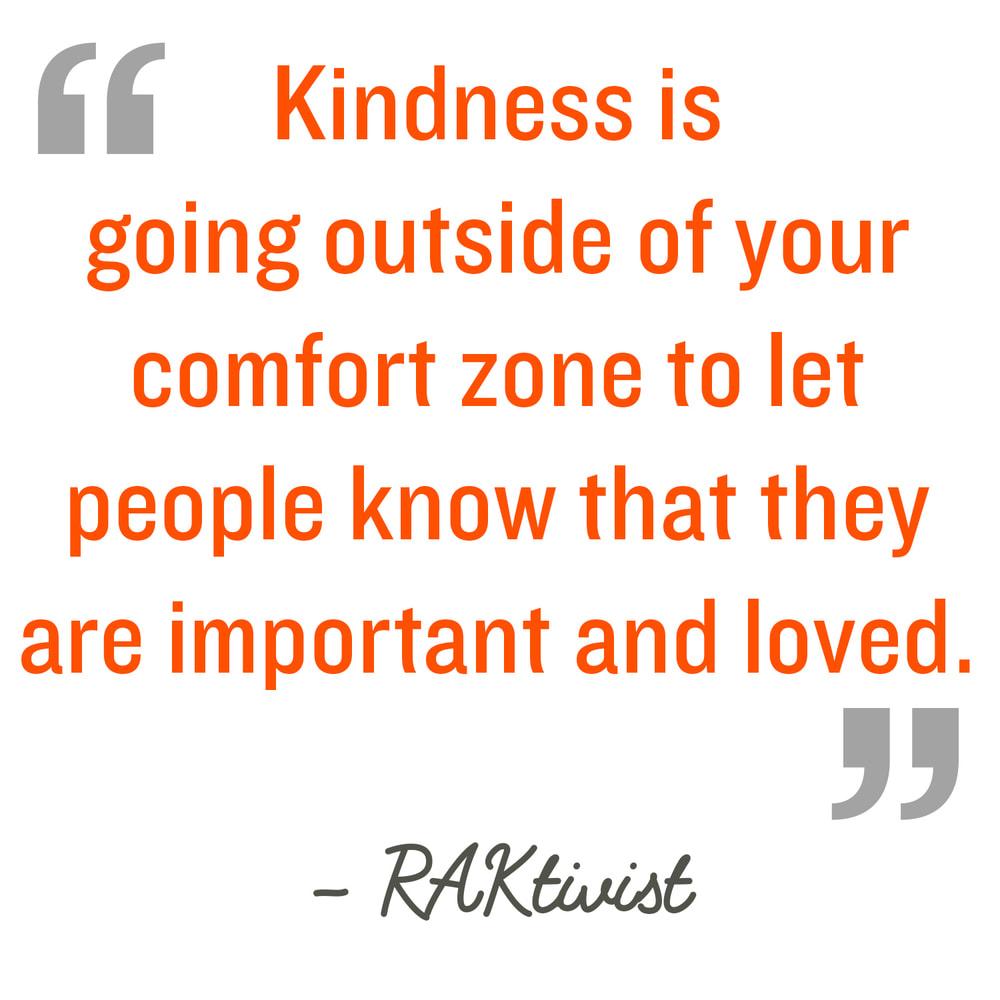
 RSS Feed
RSS Feed
